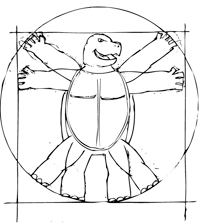I noticed a general attention of the three articles about what I consider the human filter. I guess cognition, vision, interpretation all fit into that. Catherine Ingraham mentions that "architecture depends on the orthogonalities of intentions, creativity, and intuition" and that the "humanist world is mapped rather than constructed". She is bringing about the question of the separation between physical space and perceived space, and the relativity of the world's physical properties considering the necessary filter through the human eye and cognition. I would argue that the mapped humanist world is in fact the constructed world, since, like Ingraham mentions, there is a backward relationship between what is mapped by the individual and what is constructed by the same. According to Ingraham, "we would not have the category of 'real world' were it not for its contrapuntal relation to representation". The line is a highly economical apparatus for our interpretation of the world. In a general perspective, all design is to some extent the human attempt to intellectually and ideally physically organize the world to its ideal linearity.
I see Ingraham's comment on contemporary theory's suggestions that architecture is as dematerialized as our system of languages and must employ itself as a critique of contemporary theoretician. "Potential Performative Effects" refers to the advances of technology as a tool for design process through the automative processes of technology to create new effects. While the linearity of traditional architecture described by Ingraham is very predetermined, Rahim's "contemporary processes allow for exploration of the possibilities". While our innate characteristic to use lines to determine space perceived and determine space created by lines has led architectural design for most of our history, Rahim argues that contemporary cultural production allows for the future to not be preconceived. I see Rahim's article as an idealized manifesto for what I have noticed to be the gestalt of academic architects looking for organic design processes. The dichotomy between Rahim's manifesto and most academic designs has been the interpretation of the "unlimited potential in the system which [grows] in complexity, [evolves] and [forms] mutual associations between site stimuli and event". Rahim talks of a potential for new architecture that is functionally associated with contextual function, not necessarily aesthetically associated with contextual function. The technologically facilitated architecture should be more organic, alive even, albeit not sculpturally avant-garde per se. I found the possibilities of ecological specificity, flexible organization, and gradients between extremes the most potentially useful facilitations of contemporary techniques.
I think the aesthetic relation between the supposed organic architecture look and its function relates to Perez-Gomez and Pelletier's observations of the "perspective hinge", since "architectural conception and realization usually assume a one-to-one correspondence between the represented idea and the final building". They speak of the visual necessity to create order and meaning to space, interrelated to music and art. They relate the human attempt at order as the natural characteristic of desire in our souls. To seek what we desire gives us an objective and reason to take action in life. Taking into consideration desire as part of the design process, I cannot hold it against an architect that attempts to symbolize his desire to create an organic contextual building through sculptural means, but I would love to see more architecture that takes advantage of our technologies not only for lustful aesthetics, but for unconsciously perceived functionality since we had not just one but five senses to relate our designs to.

2 comments:
if linearity is the product of human idealization, then the illusion of lines in reality is but a commentary of worldly imperfection.
lin...what? anyways, I think the idea of using advanced architecture to subversely relate ideas of functionality is intriguing. However, does a staircase always lend itself to its obvious function as stairs? I feel that some architecture has this sort of property built in. However, if a concert hall is to really be a concert hall does it also have to be a gathering space, a cafe, a sophisticated retreat for the upper class of our society? How can one go about such things (I think is the first question)? But then, why would someone go to a building if they didn't know the function before hand? I feel that unfortunately it is very rare to stumble upon a building and have to search for the function. I'm not sure our human society is ready for such a step...
Post a Comment